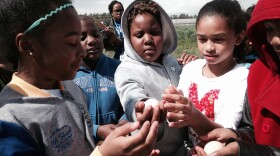You’ve probably seen it in your garden, along roadways, just about everywhere: Garlic Mustard. It’s an invasive plant that stealthily out-competes native species, threatening the diversity of forests in many parts of the country. But what if there were a recipe to change that?
They don’t call it garlic mustard for nothing. Rachel Collins is Associate Professor of Biology at Roanoke College.
“The chemical that it’s making that smells like garlic is one of these herbivore defense chemicals like basil and all the other yummy flavors in bail and mint.”
A community ecologist, Collins been studying the invasive species, as it takes over forestlands.
“So I’ve seen areas where you walk into a a forest and the whole understory is just like a blanket of garlic mustard.”
We’re walking on the Huckleberry Trail in Blacksburg, a well-traveled paved path through a narrow swath of woods. Along the edges we see the familiar heart shaped leaves with tiny white flowers on tall stems. The garlic mustard seems to have the jump plants near it.
“One of the reasons it is a bad invasive is because it can actually start out in an area like this, highly disturbed and move into an undisturbed forest.”
A troop of rambunctious preschoolers is walking toward us. The garlic mustard too, travels on foot, well sort of. The tiny seeds are easily picked up on shoes, hooves and bicycle tires.
“I’ve seen in some parks, as you walk into the park, there will be a little station there with brushes and they’ll ask you to brush off your shoes to remove any seeds that might be on your shoes so you don’t spread invasives.”
Collins has been studying plots of garlic mustard woodlands around the New River Valley for the past 6 years to learn more about why it’s so successful in the competitive plant world.
“One idea is that with really abundant white tail deer, they like to eat native plants, so they’ll eat all the native plants and then that allows a non-native plant to be able to come in and take over like garlic mustard. So some people think that it’s not that plants like garlic mustard are directly competing with native plants, but rather, they’re released from competition because something else is disturbing or eating the native plants.”
The local deer population may take a pass, but in Europe where Garlic Mustard came from in the 1860s, humans have been eating it centuries. So does Rachel Collin.
“You certainly can just pull it because it pulls up really easily.”
She’s picking only the young leaves and putting them into a bag. We take the bag of garlic mustard leaves into the kitchen where Collins is giving them a good rinse. She’s created her own recipe for garlic mustard pesto.
“So now we’re ready for our other ingredients.”
She peels and chops a clove of actual garlic to enhance the faux garlic of the mustard plant.
“This is really pretty easy.”
It goes into the blender with olive oil, Parmesan cheese, and walnuts.
Collins plates the bright green garlic mustard pesto on crackers with red tomatoes and cooks up a pot of pasta for the second course. It’s delicious and maybe extra satisfying to know there’s just a tiny bit less garlic mustard out there. And if this catches on there could be a lot less.
“So we could come to the farmer’s markets in Blacksburg and see people selling bags of garlic mustard that they have gone out and harvested.”
Collins says she'd gladly give harvesting and cooking demonstrations and she’s happy to share her recipe for garlic mustard pesto:
2 cups packed garlic mustard leaves
½ cup coarsely chopped walnuts
½ cup grated parmesan cheese
1 clove garlic, chopped
½ cup extra virgin olive oil
Salt to taste.
Remove stems from garlic mustard eaves and place leaves in a large bowl of water to wash off the dirt and insects. Empty the water and repeat. After a turn through a salad spinner place leaves on a dish towel to get excess water off the leaves.
Coarsely chopped the garlic mustard. Put garlic mustard, walnuts, garlic, and parmesan to a blender with ¼ cup of olive oil. Blend until the pesto is a smooth paste. Add the other ¼ cup of olive oil as needed to make paste form.
As a meal: Toss 1 to 1.5 tablespoon of pesto per serving of cooked drained pasta. Add chunks of cook chicken, fresh tomatoes, and mushrooms.
As an appetizer: Put dollop of pesto on crackers garnish with small slice of parmesan or fine chopped cucumbers and tomatoes.
Save left over pesto in a container in the refrigerator for about 1-week. To preserve for longer, fill empty ice cube tray with pesto. Freeze overnight. Transfer pesto cubes to a freezer bag or container. Keeps for several months.






